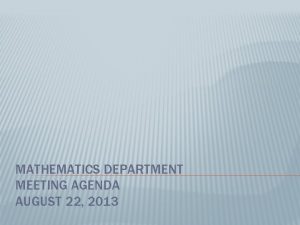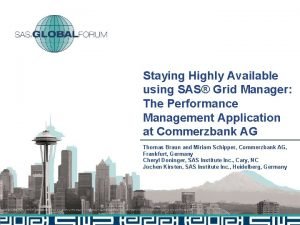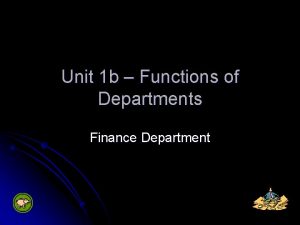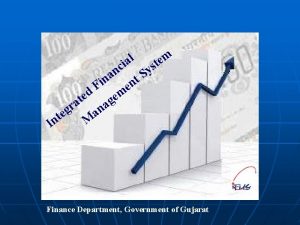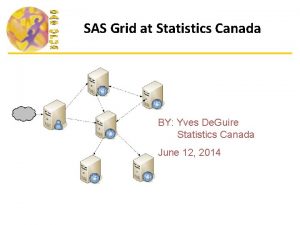SAS Grid Department of Finance Canada Agenda SAS















- Slides: 15

SAS Grid Department of Finance Canada

Agenda • • • SAS in the Department of Finance Before the implementation of SAS Grid Implementation of SAS Grid Effect on users Performance Conclusion

SAS at Department of Finance • SAS has been used for more than 25 years. • Between 60 to 70 users. • Mainly used with Tax Data. (Sales Tax, Personal Income Tax and Business Income Tax). • Tax Modeling, Data querying, SAS OLAP Cubes are the main functions used in SAS. • Analysis of Tax Measures in Federal Budget. • Around 10 TB of data. With 10% growth every year.

Before SAS Grid • The Department had 3 Application servers. (1 per Business unit) • 1 Shared SAS Enterprise Business Intelligence architecture (including OLAP server and Web server). • 1 Metadata Server.


Implementation of SAS Grid 1. SAS and Finance met to discuss our needs. 2. Finance filled out the SAS Sizing Documents 3. SAS made their architecture recommendations 4. SAS, Finance and Shared Services Canada discussed the SAS recommendations. 5. SSC bought the recommended hardware and configured it.

Implementation of SAS Grid 6. Finance and SAS installed and configured SAS Grid. 7. Finance migrated all their data. 8. Main users switched to SAS Grid. 9. Finance customized and made final adjustment on the new infrastructure. 10. All users are now on SAS Grid.


Effect on Users • For now, Finance do not force users to connect to SAS Grid – Platform LSF. • For SAS Enterprise Guide Users: – Only one server (SASGrid), instead of 3 when a user had access to all data. Less confusing. • For Base SAS Users: – 1 new icon on their Toolbar Local submit Grid Submit Remote Submit


Effects on Users • It’s easy to run job on the grid. Basically no impact on users. • However, to be able to take full advantage of the grid, some programming skills are necessary. – Running jobs in parallel. – Understanding SASWork.

Effects on Users - Work • One of the negative effect of SAS Grid, is the use of Work. – As each job on the grid starts its own session, then the Work is deleted after the job. So, all your “work” tables are then deleted. Thus, they aren’t displayed in your project.

Performance • Our new SAS infrastructure includes brand new physical servers, a new Cluster File System, new OS. – So the performance of all of our SAS Jobs are faster even if we do not take advantage of SAS Grid. – These new infrastructure seems to had improved the performance by around 25%.

Performance • As users are now using the best server available and not their dedicated one, this has a potential to improve the performance. – Sometime a dedicated server was quite busy and the 2 others were not. – This cannot be measured. • Running jobs in parallel has also improved the performance. – For example, a 45 min job on the older server now take 3 min when ran in parallel. – It is important to note that not all jobs can be parallelized.

Conclusion • Even if we aren’t using SAS Grid at its full capacity yet, it has helped the Department to improve the performance of our SAS jobs. • No decision has been made yet on if we should force SAS Grid or not. • Even if the impact on users is small, some training has to be given to fully utilized the system.
 Agenda sistemica y agenda institucional
Agenda sistemica y agenda institucional Lga vs pga socket
Lga vs pga socket Math department meeting agenda
Math department meeting agenda Proc scaproc
Proc scaproc Sas grid computing
Sas grid computing Sas grid computing
Sas grid computing The finance department
The finance department Finance department
Finance department Finance department functions
Finance department functions Finance dept structure
Finance dept structure Dept of finance and administration
Dept of finance and administration State of alabama department of finance
State of alabama department of finance Minutes of meeting finance department
Minutes of meeting finance department Department of local government finance
Department of local government finance Ms department of finance and administration
Ms department of finance and administration Healthcare finance department structure
Healthcare finance department structure


